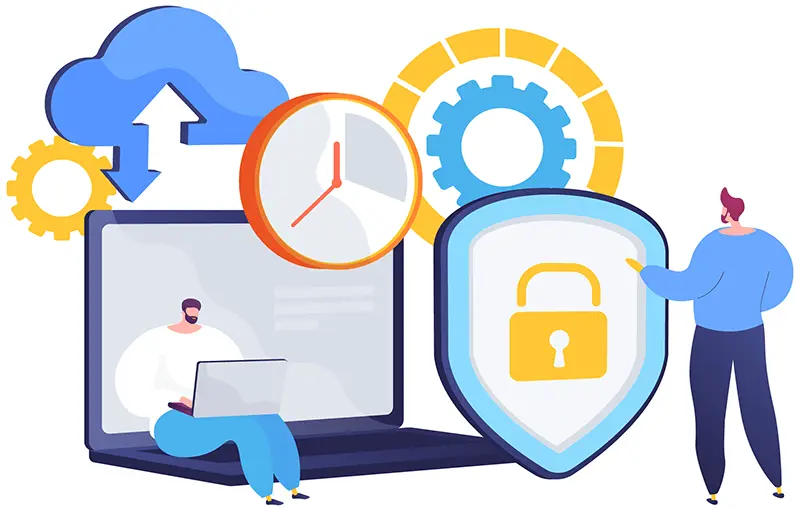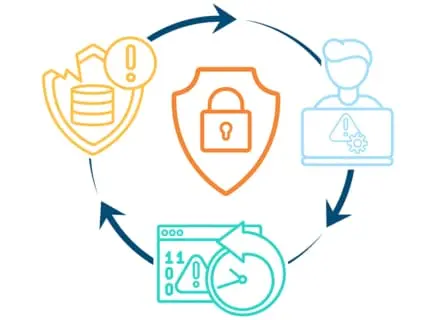
What is cross-cloud disaster recovery (DR)?
Cross-cloud disaster recovery (DR) is a way to protect your business by backing up critical data and applications across multiple cloud providers and regions. This procedure ensures that if one system fails, your business can quickly recover and continue running without major disruptions.
How cross-cloud disaster recovery works
Real-time workload replication
- Continuous data synchronization between primary and secondary cloud environments.
- Incremental replication to minimize bandwidth usage and ensure up-to-date backups.
Automated failover & failback
Application-consistent backups
Multi-cloud & hybrid cloud support
Non-disruptive disaster recovery testing
Cost-efficient and optimized storage management
- Deduplication and compression reduce storage costs.
- Incremental backups prevent redundant data storage and optimize cloud resources.
Seamless cloud-to-cloud migration & recovery
- Enables businesses to migrate workloads between clouds while maintaining DR protection.
- Supports hybrid and multi-cloud DR strategies for better resilience.
Why cross-cloud disaster recovery is essential for companies
In today’s digital landscape, businesses cannot afford unexpected downtime or data loss. Cross-cloud disaster recovery (DR) provides a robust solution, ensuring Business Continuity, security, and compliance across multiple cloud providers. Here’s why it matters:
Protection against cloud provider outages
Even the most trusted cloud providers, such as AWS, Azure, Google Cloud, and OpenStack, can experience outages and service disruptions. When a business relies solely on a single provider, a failure in that environment can lead to costly downtime and lost revenue.
Solution
A cross-cloud DR strategy allows workloads to automatically switch to another provider when one experiences issues, minimizing disruptions and ensuring uninterrupted operations. Implementing automated cloud-to-cloud replication helps businesses reduce dependency on a single provider and enhances reliability.

Regulatory and compliance requirements
Industries like finance, healthcare, and government must comply with strict data protection and redundancy regulations. Laws such as GDPR, HIPAA, and SOC 2 require businesses to have disaster recovery solutions that include geographically and infrastructurally diverse backup systems.
Solution
A cross-cloud DR approach ensures data is stored across multiple regions and providers, helping businesses meet compliance requirements while maintaining secure and resilient systems.
Cybersecurity and ransomware resilience
Cyber threats like ransomware attacks, DDoS attacks, and data breaches can compromise entire cloud environments, leading to data loss, financial damage, and reputational harm. Businesses relying only on a single cloud provider may find their critical data inaccessible if an attack occurs.
Solution
By replicating real-time data to a secondary cloud, businesses can maintain access to important data even if their primary cloud is compromised. This proactive approach ensures faster recovery and reduces the impact of cyber incidents.
Avoiding vendor lock-in risks
Relying on a single cloud provider has a lot of risks, including unexpected price increases, policy changes, or service discontinuations. Businesses locked into one provider may struggle to negotiate better terms or migrate their workloads efficiently.
Solution
A multi-cloud DR strategy allows businesses to move workloads between providers as needed. This capability reduces vendor dependency, improves cost efficiency, and ensures smooth disaster recovery in case of unexpected changes.
Global reach & Business Continuity
For businesses with a global customer base, regional outages can lead to service disruptions, loss of trust, and financial losses. Without a multi-region failover system, customers in affected areas may experience downtime, negatively impacting the user experience.
Solution
A cross-cloud DR strategy ensures that failover mechanisms are in place to seamlessly switch workloads to another cloud provider or region. This procedure guarantees uninterrupted service for users worldwide, no matter where a disruption occurs.

How Hystax helps companies perform cross-cloud disaster recovery
In today’s multi-cloud environment, cross-cloud disaster recovery is no longer optional—it’s a business necessity. Whether mitigating cloud outages, cyber threats, compliance risks, or vendor lock-in, organizations need a robust multi-cloud disaster recovery strategy to protect data, minimize downtime, and stay resilient.
Hystax Acura offers a fully automated cross-cloud disaster recovery solution. It allows organizations to replicate and recover workloads across AWS, Azure, Google Cloud, OpenStack, and private cloud infrastructures.
- Live cloud-to-cloud migration and failover (AWS, Azure, Google Cloud, OpenStack, etc.)
- Automated disaster recovery testing to validate failover scenarios
- Incremental replication and cost-effective backup to reduce expenses
- Complete application and workload protection, ensuring seamless Business Continuity
Why Disaster Recovery as a Service (DRaaS) is essential for your business: top 7 reasons →

